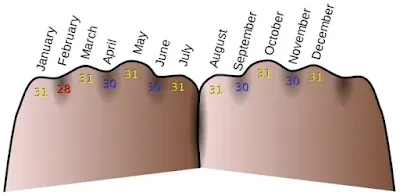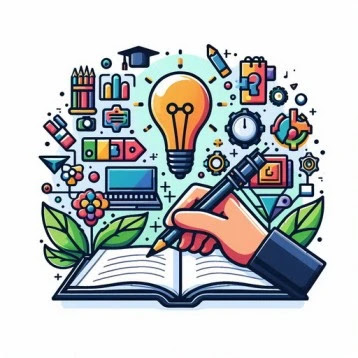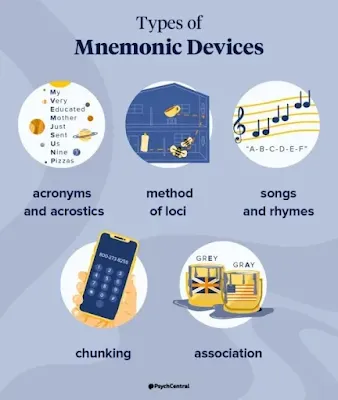Introduction:
Mnemonic
techniques are ways
to help you memorize a phrase or idea with patterns. Mnemonic techniques can include
songs, poems, rhymes, outlines, images, and acronyms. Mnemonic devices
were cultivated by Greek sophists and philosophers and
are frequently referred to by Plato and Aristotle. In this blog, we will
explore the mesmerizing world of mnemonics and how these techniques can boost
memory and learning.
Examples from Daily Life:
Ever
wonder when you reach your hometown after a long time, suddenly you remember
the names of your neighbors and childhood friends?
I
remember I bought an Urdu book in 1987 by post from Karachi. The Name of the book
was “How to Succeed in Examination” and different techniques were given in that
book. Since the book has been lost due to frequent shifting of luggage due to
service requirements, I still remember the salient features of the book. The techniques mentioned in the book were
about:-
➤ Reading the lesson
➤ Revising the lesson
➤ Assimilation of the lesson
➤ Making a mind image of the lesson read, and then writing it down without seeing the book.
This
book helped me a lot and I got good marks in my matric (Secondary School Certificate)
with a Scholarship.
The
best way was to imagine complete pages and I still remember some lessons about
the elements table, the water cycle, Darwin's theory, a few theorems like
Pythagoras the Scientific name of frog Rana Tigrina and the fourteen
points of Quaid e Azam Muhammad Ali Jinnah, etc
Javed
Chaudry, a well-known Pakistani Columnist who can remember up to half of the
book, in his recent column also mentioned his good memory as a blessing of
Allah.
HenryKissinger, who died in the last week of November this year, had a good memory and
even wrote on the last day of his life at 100 years. He wrote many books like World
Order, On China and co-authored The Age of AI and Our Human Future.
SMZafar, a Great Pakistani lawyer, also had a Photographic memory. He wrote many books
in Urdu and English. One of his famous books is “Understanding Statutes”.
The brain remembers images better than words.
I
have been using the Mindtools website for many years and it explains memory
techniques with diagrams that are easy to remember.
One method to remember names is to start recalling
names from A,B,C onwards, you will hit the desired name soon. Remembering the
names of the months in poem form. Colors of the rainbow by making keywords
taking the first letter of each word. The keywords should be easy to remember
and should resemble to something already known.
These memory aids transform complex
or abstract information into more easily digestible formats, making it simpler
for the brain to store and retrieve.
 |
| (Knuckle technique) |
Mnemonics Techniques:
1. Acronyms and Acrostics:
Acronyms involve creating a word or phrase where each letter
represents a piece of information. For example "Big Elephants Can not Always Understand Small
Elephants" (can be spelled in the word "Because").
2. Rhymes and Songs:
Creating rhymes or songs can turn dull information into catchy tunes,
making it easier to remember. The sing-song rhythm enhances memorization, and
many people find it fun and engaging. Like in our Schools, we used to remember
tables.
3. Chunking:
Chunking involves breaking down large amounts of information into
smaller, manageable parts or "chunks." For instance, remembering a
phone number as three sets of numbers (e.g., 123-456-7890) is easier than
trying to remember each digit individually.
4. Loci Method (Memory Palace):
This technique involves associating each piece of information with a
specific location in a familiar setting, like your home or a well-known
landmark. As you mentally walk through these locations, you can repossess the
associated information.
5. Visualization:
Creating bright mental images related to the information you want to
remember enhances recall. The more peculiar or amusing the image, the more
likely you are to remember it.
6. Keyword Method:
This technique involves selecting a keyword related to the information
you want to remember and creating associations between the keyword and the
details. This is particularly useful for learning new languages.
 |
| (AI-Generated Image) |
Benefits of Mnemonics Techniques:
1. Enhanced Memory Retention:
Mnemonics capitalize on the brain's preference for associating
information with images or patterns, leading to improved retention and recall.
2. Increased Engagement and Motivation:
Mnemonics can make the learning process more enjoyable and
engaging, motivating individuals to actively participate in their learning
journey.
3. Applicability Across Various Fields:
Mnemonics are versatile and can be applied to almost any type of
information, from historical dates to scientific facts and foreign language
vocabulary.
4. Time-Efficient Learning:
By simplifying complex information, mnemonics enable individuals to
learn more efficiently, saving time and effort in the process.
Conclusion:
In this world of AI and the Internet
filled with a constant flow of information, mastering memory through mnemonic
techniques is a valuable skill. Whether you're a student of CSS/PMS, MDCAT, or
ISSB preparing for competitive exams, a skilled striving for the highest
performance, or someone seeking intellectual enhancement, mnemonics techniques
offer a multipurpose and effective approach to remembering and recalling
information., You can unlock the full potential of your memory by the power of
mnemonics.







5 Comments